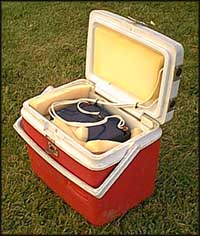Looking After Your Batteries
The most important thing you can do to increase battery life is to treat your batteries properly.
There are many different types of batteries, and different types require different treatments. Find out what kind of batteries you have, and how they should be cared for.
For example, Nickel-Cadmium (Ni-Cad) batteries should not be recharged until they are completely drained of power. This means that if you use half the battery's charge during a shoot, don't recharge it. Instead, either leave the battery until your next shoot and continue using it then, or leave your camera running until the battery is drained. Then you should recharge the battery without interruption until it regains a full charge. Failing to treat Ni-Cads this way results in reduced power capacity.
On the other hand, lead-acid batteries should be recharged after every use, even if only a small amount of their charge has been used.
When using devices which require more than one battery, don't mix-and match batteries of different charges. One bad battery can place too much load on the good ones, and shorten their life.
Bear in mind that rechargeable batteries will not stay fully-charged sitting on the shelf. They begin to lose their charge after a few days, and will lose about 5% of their charge every day thereafter. This is why batteries are shipped uncharged.
Batteries are sensitive to extreme temperatures, and won't perform well below 0 degrees Celcius (32 dF) or above 40 degrees Celcius (100 dF).
Don't recharge very hot or very cold batteries -- allow them to return to normal temperature first.
Here are some power-saving tips for camera operations:
- Use a mains-power adaptor whenever possible.
- Turn the camera off if you're not going to be shooting for more than a few minutes.
- If your camera has a "power save" function, use it. This unloads the tape from the record head and shuts down some of the camera mechanics. The drawback is that it takes longer for the camera to begin recording when you hit the record button.
- If your camera has a manual zoom ring, use it instead of the servo zoom lever. If you're using a servo-zoom, don't use it unless you have to.
- Don't use the camera to playback footage.
- Minimise usage of the camera's electronic systems such as colour bars, gain, etc.
- Accessories such as lights, if powered from the camera, will obviously draw more power.

This picture shows a 12V motorcycle battery housed in a "chilli-bin". The battery is connected to two XLR-4 sockets on the lid, allowing for easy connection.
This unit is cheap, versatile, robust, waterproof, and insulated against temperature changes. It will power a typical television camera for at least half a day, and recharge in about an hour.